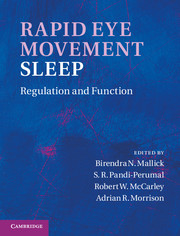Book contents
- Frontmatter
- Contents
- Contributors
- Preface
- Acknowledgments
- Organization
- Section I Historical context
- Section II General biology
- Section III Neuronal regulation
- 10 Understanding REM sleep: clues from brain lesion studies
- 11 Preoptic and basal forebrain modulation of REM sleep
- 12 Amygdalar regulation of REM sleep
- 13 Pontomedullary mediated REM-sleep atonia
- 14 Phenomenology and function of myoclonic twitching in developing rats
- 15 Pontine-wave generator: a key player in REM sleep-dependent memory consolidation
- 16 Hippocampal theta rhythm of REM sleep
- 17 Respiration during REM sleep and its regulation
- 18 Modulation of REM sleep by non-REM sleep and waking areas in the brain
- Section IV Neuroanatomy and neurochemistry
- Section V Functional significance
- Section VI Disturbance in the REM sleep-generating mechanism
- Index
- Plate section
- References
17 - Respiration during REM sleep and its regulation
from Section III - Neuronal regulation
Published online by Cambridge University Press: 07 September 2011
- Frontmatter
- Contents
- Contributors
- Preface
- Acknowledgments
- Organization
- Section I Historical context
- Section II General biology
- Section III Neuronal regulation
- 10 Understanding REM sleep: clues from brain lesion studies
- 11 Preoptic and basal forebrain modulation of REM sleep
- 12 Amygdalar regulation of REM sleep
- 13 Pontomedullary mediated REM-sleep atonia
- 14 Phenomenology and function of myoclonic twitching in developing rats
- 15 Pontine-wave generator: a key player in REM sleep-dependent memory consolidation
- 16 Hippocampal theta rhythm of REM sleep
- 17 Respiration during REM sleep and its regulation
- 18 Modulation of REM sleep by non-REM sleep and waking areas in the brain
- Section IV Neuroanatomy and neurochemistry
- Section V Functional significance
- Section VI Disturbance in the REM sleep-generating mechanism
- Index
- Plate section
- References
Summary
Summary
There have been many studies of the atonia of REM sleep and of its effects on the respiratory system. In contrast, excitatory processes that affect the respiratory system in REM sleep are poorly understood. Nevertheless, these processes may be the main determinants of respiratory behavior in REM sleep (e.g., the higher rate of breathing). In this chapter, findings relevant to excitation of the respiratory system in REM sleep are presented and discussed.
Most medullary respiratory neurons are more active in REM sleep than in NREM sleep, and both diaphragmatic and hypoglossal motor neurons reportedly have greater overall activity in REM sleep than in NREM sleep.
The source of the excitation of respiratory neurons and motor neurons in REM sleep is internal because excitation is seen even when mechanical and chemical respiratory stimuli are removed or held constant and respiratory drive is eliminated.
[…]
- Type
- Chapter
- Information
- Rapid Eye Movement SleepRegulation and Function, pp. 164 - 172Publisher: Cambridge University PressPrint publication year: 2011



